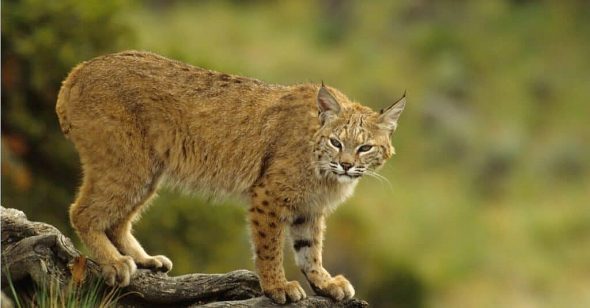
According to the Ohio Department of Natural Resources, Ohio now supports an established bobcat population in the eastern and southern parts of the state, and the population is continuing to expand into other areas of suitable habitat. (Photo: iStock.com)
Down to Earth | Bobcats and coyotes and foxes: Oh, yes!
- Published: February 23, 2024
By Don Cipollini
Each year the presence of bobcats, coyotes and other predatory mammals are reported either in the village or in surrounding areas, and those reports are sometimes met with shock and fear. I suggest that those reports should be met with a little caution, but mostly with an appreciation that starts with a solid understanding of their presence and role in natural and human-dominated ecosystems.
Historically, Ohio was home to many large predators, including black bears, gray wolves, cougars and bobcats, as well as their larger prey, including elk, bison and white-tailed deer. Populations of these predators and their prey declined steadily through the 1800s through habitat destruction and overharvesting, and most were eliminated from the state by 1900, except for rare occurrences.
Through conservation and restoration efforts, along with natural dispersal from surrounding states, coyotes entered our state from the west for the first time around 1930, expanding ever since; and populations of black bears have steadily increased for the last 50 years. Bobcats have made a particularly meteoric rise in the state of late, from being practically unseen in 2000 to being considered common now. Elk and bison and their chief predators, wolves and cougars, have never returned to the wild in Ohio, but white-tailed deer have rebounded from too few to count in 1900 to nearly 800,000 now. Populations of smaller predators, such as red foxes, mink, otters and weasels have also increased on their own and in response to reintroduction efforts.
Populations of these predators cannot rise indefinitely, however, and depend on the availability of suitable habitats and prey, as well as the whims of the weather and disease. But their presence signals that the environment is healthy enough to support these creatures, which they in turn help to maintain through their regulation of prey populations.
Locally, red foxes are very common in the village, as are coyotes in and outside of town; I’ve seen both in my yard. Bobcats have never been confirmed in the village to my knowledge, but there have been confirmed sightings in Greene and Clark counties in recent years. Our local predators feed primarily on small vertebrates, such as rabbits, squirrels, mice and birds, but while bobcats are almost entirely carnivorous hunters, foxes and coyotes will also scavenge for food and eat fruit and other plant materials.
Coyotes also prey on deer occasionally, taking mostly young deer or sick, injured or dead adults. While this draws the ire of hunters from time to time, their predatory impact on deer populations cannot keep up with the reproductive potential of deer in this area. I routinely see 25 deer in a field at the end of Spillan Road — the same field where I regularly see and hear coyotes — and I have an acquaintance who’s reported seeing 45 deer at once in the field where Vernay Labs once stood!
With all this seemingly good news about the return of predators, is there any cause for concern? First, attacks on humans by coyotes or bobcats have happened, but are extremely uncommon, especially in Ohio, so this possibility should be of little concern to most people. However, coyotes and bobcats will occasionally take pets, especially cats and small dogs, along with backyard chickens, as will many other predators. Like raccoons and opossums, coyotes and foxes will also scavenge in open trash containers or eat food of many sorts left outside.
The best solution to these issues is to keep your pets under your direct control when outside, keep chickens in predator-proof environments and provide safe hiding spaces for them, and keep trash and other sources of food from accumulating outside. It almost goes without saying that one should never feed them directly. These practices will discourage predators from sidling up to the buffet on your back porch and instead encourage them to pursue their livelihood in natural areas in and outside of town, maintaining a healthy fear of humans and avoiding human conflicts.
While it is great to see them from a comfortable distance, the “wilder” that our natural predators can remain, the better it is for both them and us.
*Don Cipollini, Ph.D., is a professor of biological sciences at Wright State University. He also hosts “The Naturalist,” a walk-and-talk nature show on Channel 5 and YouTube @TheNaturalistWithDonCipollini.
One Response to “Down to Earth | Bobcats and coyotes and foxes: Oh, yes!”
The Yellow Springs News encourages respectful discussion of this article.
You must login to post a comment.
Don't have a login? Register for a free YSNews.com account.















Excellent commentary! We need to appreciate wildlife more and stop condemning it.
Thank you.